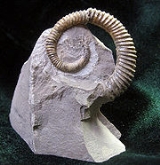
Allocrioceras
Encyclopedia
Allocrioceras is an ammonoid cephalopod from the mid-Cretaceous included in the turrilitacean
Turrilitaceae
The Turrilitacaeae is a diverse superfamily of Cretaceous ammonites generally considered as heteromorphic and commonly included in the suborder Ancyloceratina...
family Anisoceratidae
Anisoceratidae
Anisoceratidae is an extinct family of heteromorph ammonoid cephalopods.-Referenceas:*http://paleodb.org/cgi-bin/bridge.pl?action=checkTaxonInfo&taxon_no=96545&is_real_user=1...
. Its shell is strongly ribbed and is in the form of a widely open spiral.
Classification
After its 1907 discovery, the species A. hazzardi was erroneously classified as CriocerasCrioceras
Crioceras is an extinct cephalopod genus belonging to the subclass Ammonoidea and included in the family Crioceratidae of the ammonitid superfamily Ancylocerataceae. Crioceras is considered by some to be a junior synomym of Crioceratites...
latus by Udden. A later 1928 revision by Adkins removed it from the species C. latus while keeping it as a member of the Crioceras genus. In 1963 Young gave the species its final classification in a new genus- Allocrioceras.
Biology
Allocrioceras was small compared to some Ammonites. Its shell diameter was only a bit larger than an U.S. quarterQuarter (United States coin)
A quarter dollar, commonly shortened to quarter, is a coin worth ¼ of a United States dollar, or 25 cents. The quarter has been produced since 1796. The choice of 25¢ as a denomination, as opposed to 20¢ which is more common in other parts of the world, originated with the practice of dividing...
. Unlike most Ammonites its shell was partially uncoiled. Ammonites like this, with shell configurations differing from the typical tightly coiled spiral, are called Heteromorphs. It lived approximately 88 million years before present during the Turonian
Turonian
The Turonian is, in the ICS' geologic timescale, the second age in the Late Cretaceous epoch, or a stage in the Upper Cretaceous series. It spans the time between 93.5 ± 0.8 Ma and 89.3 ± 1 Ma...
stage Cretaceous Period in what is now Texas
Texas
Texas is the second largest U.S. state by both area and population, and the largest state by area in the contiguous United States.The name, based on the Caddo word "Tejas" meaning "friends" or "allies", was applied by the Spanish to the Caddo themselves and to the region of their settlement in...
. Its fossils can be found in the limestone
Limestone
Limestone is a sedimentary rock composed largely of the minerals calcite and aragonite, which are different crystal forms of calcium carbonate . Many limestones are composed from skeletal fragments of marine organisms such as coral or foraminifera....
s of Brewster and Terrel counties.
Its stomach contents and some soft parts have been found.

